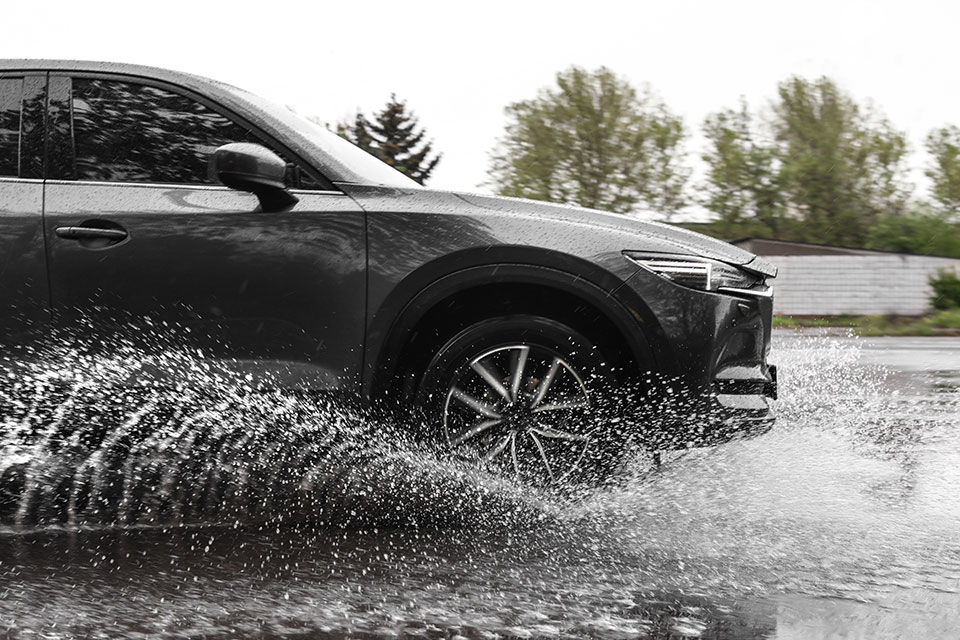Wet Weather Maintenance Tips

Wet weather, like we have been experiencing lately, can create road hazards and some detrimental effects on our vehicles. Some things to be aware of when you are driving are potholes. The ground is so saturated now that potholes are starting to appear more frequently. If you drive over a pothole, your tires and steering system can be damaged. The rubber on your tire can be pinched when you hit a large pothole. While this may not cause an immediate flat or noticeable damage, this will create a weak point in the rubber where it is pinched. This may cause blistering on the side of the tire. If the blister ruptures, your tire will rapidly lose air and create an obviously hazardous driving condition. Make sure to inspect your tires several days after hitting a pothole to make sure a blister does not appear. A blister cannot be repaired. If you notice a blister, you should get a new tire as soon as possible. A large pothole can also throw off the wheel alignment of your vehicle. If you start to notice that your vehicle is pulling to the right or left when you are driving after hitting a pothole, you should have your alignment checked as soon as possible. Driving over a pothole can also cause your wheels to go out of balance. When your wheels are out of balance you will notice a chatter or shimmy in your steering wheel while driving. If your wheels are out of balance, it creates an unsafe driving condition and additional wear on your tires you should have your wheel balance checked as soon as possible.
An often-overlooked area of vehicle maintenance is your vehicle’s drains. All vehicles have drains to eliminate water that accumulates from rainfall or having your car washed. Over time drains can become clogged by dirt, leaves or other debris. When a drain is clogged, accumulated water cannot exit and will pool in the vehicle creating extra weight and causing rust. If you notice constant wet spots in your vehicle’s carpet, water stains on your door panels, your sun or moon roof is leaking or hear water sloshing around in your vehicle it could be an indication that your vehicle’s drain is clogged, and water is not draining properly. You should have your drains checked as soon as possible.
If you are experiencing any of these issues, please give the shop a call so we can get your vehicle taken care of and get your back on the road safely.
.png)
Don’t idle your car first before driving it
The best thing to do to warm your car quickly during cold temperatures is to get in and drive. Most parts of modern engines can’t warm up just by idling.
Never pour boiling water on the windshield
You could actually break the windshield if you do. Glass cannot go from freezing to high temperatures quickly. If it does, it could shatter.
What to do—and NOT do—when you hydroplane or hit black ice
Hydroplaning occurs when your tires encounter more water than they can scatter so they lose direct contact with the road and your car skids or slides. You’re most likely to hydroplane during the first 10 minutes of rain or snow as oils and grease on the road mix with water and create extra slippery conditions. Still, hydroplaning can happen on wet roads at any point, so use caution. In cold weather conditions, you’re also at risk of hitting a patch of black ice, a transparent (read: invisible) coating of ice that forms during rainfall with temperatures at or below 32 degrees Fahrenheit.
Both experiences can be dangerous, but if you prepare ahead, you can avoid acting out of fear and instead take steps to continue safely on down the road:
- Don’t accelerate or brake quickly because hydroplaning means you’ve lost traction with the road, and sudden changes in speed could cause you could spin out.
- If you have front-wheel drive (with or without ABS and traction control) or rear-wheel drive with ABS and traction control, look for open space and plan to travel in that direction.
- Accelerate just a little and steer gently – without sudden movements – in the direction of the open space.
- If you have a rear-wheel drive without ABS or traction control, you should still head toward an open space, but instead of applying pressure to the accelerator, ease off it as you steer to the open space.